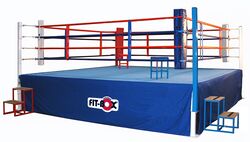Boxing ring
Topic: Engineering
 From HandWiki - Reading time: 3 min
From HandWiki - Reading time: 3 min
A boxing ring, often referred to simply as a ring or the squared circle, is the space in which a boxing match occurs. A modern ring consists of a square raised platform with a post at each corner. Four ropes are attached to the posts and pulled parallel under tension with turnbuckles to form the boundary of the competition area.
Construction
As there are a number of professional boxing organizations, the standards of construction vary. A standard ring is between 16 and 24 feet (4.9 and 7.3 m) to a side between the ropes with another 2 feet (0.61 m) outside. The platform of the ring is generally 3 to 4 feet (0.91 to 1.22 m) from the ground and is covered by about 1 inch (25 mm) of padding topped by stretched canvas. The ropes are approximately 1 inch (25 mm) in diameter and at heights of 18, 30, 42, and 54 inches (.46, .76, 1.07, and 1.37 m) above the mat, held up on posts rising around 5 feet (1.5 m) above the mat. The ropes are attached together with spacers that prevent them from spreading too far apart.
Construction of the ring environment extends to maximization of lighting in the ring, minimization of heat of the lighting, and a complete as possible cut-off of illumination at the ringside.[1]
Construction differs from the similar wrestling ring. A wrestling ring sports only three ropes (which may be sheathed steel cable) and is constructed to provide a more flexible mat surface than a boxing ring.
Terminology
The name "ring" is a relic from when contests were fought in a roughly drawn circle on the ground. The name ring continued with the London Prize Ring Rules in 1743, which specified a small circle in the centre of the fight area where the boxers met at the start of each round. The first square ring was introduced by the Pugilistic Society in 1838. That ring was specified as 24 feet (7.3 m) square and bound by two ropes. For these and other reasons, the boxing ring is commonly referred to as the "squared circle". The term "ringside seat" dates as far back as the 1860s.[2]
See also
- Ring girl
- Dohyō
- Octagon (mixed martial arts)
References
- ↑ Transactions -Illuminating Engineering Society (London, England) - 1952 Volumes 17-18 - Page 178 "There cannot be very many gymnasia where there is not sufficient general lighting to allow practice bouts to take place under perfectly satisfactory conditions. For a big fight, however, the amount of light can hardly be too great, and the heat that goes with these high values of illumination is a discomfort with which the boxers must contend as best they can. The method usually used to confine the light to the ring and give a cut-off as complete as possible at the ringside is illustrated in Fig."
- ↑ Christine Ammer Southpaws & Sunday Punches and Other Sporting Expressions - 1993 1618422618 "The term "ringside seat" dates as far back as the 1860s. During the course of the century, however, it began to be used quite generally for a good view (literal or figurative) of any event, not necessarily an athletic one."
 |
 KSF
KSF
